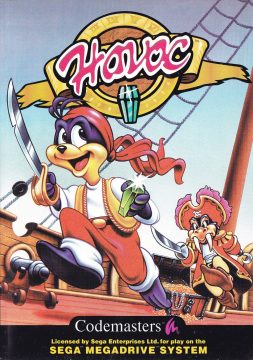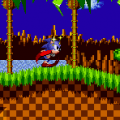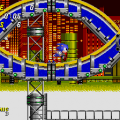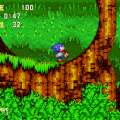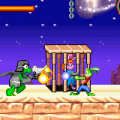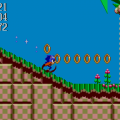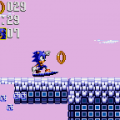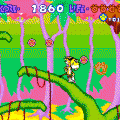Among their various arcade conversions for the Mega Drive, Data East released an original title which also capitalized on the mascot platformer craze of the early-mid 90s. High Seas Havoc is solid enough in its mechanics and backed by gorgeous presentation, but it’s a ludicrously tough game that’s hard to recommend for most players.
You play as the pirate seal Havoc, who goes on adventures with his young sidekick Tide. One day, they find a girl named Bridget washed ashore, clutching a map, and help her to recover. She tells them that the map contains the location to Emeralda, a magical gemstone with great power which is being hunted down by the fierce pirate Bernardo and his crew. Although they hide the map, one of Bernardo’s henchmen finds and kidnaps Bridget and Tide, leaving Havoc alone to rescue them and defeat the pirates before they find Emeralda.

High Seas Havoc is a side-scroller where your goal is to reach the end of the stage, jumping over obstacles and onto enemies, avoiding hazards and collecting treasure along the way. You can perform a mid-air kick to damage bosses and certain enemies, duck down, and do a forward roll underneath low-bearing obstacles and foes. Dotted all over the place are gems, which give you an extra life once you collect 100, and you can find further treasures inside various chests, along with food to heal you, more lives, and boots that increase your running speed and jumping distance.
You’ll need those boots too, considering how often the level design asks you to jump across tight gaps while avoiding enemies. Although stages can offer up more open spaces to explore, with secrets to find and even the odd alternate route, precise platforming is what takes up most of the adventure. The controls do a good job at accommodating this, with responsive movement and jumps that let you deal with most obstacles in time. That said, the mid-air kick isn’t much help, owing to a slightly unclear hitbox that makes it harder to hit enemies.
It’s best used against the bosses that appear at the end of every other stage, since you can’t bop them on the head. These fights have you waiting for the right time to attack, though you can get in some extra hits if you’re fast enough. Unfortunately, doing so is a risk as you can only take so many hits and will have to start over if you die, which makes them feel even more long-winded. At least you get checkpoints just before the fight, so you don’t have to repeat certain sections.

That’s a good thing, because High Seas Havoc starts to become almost ruthlessly challenging after just a few levels. It starts with the fifth stage Burning Hamlet 1, where you’re being constantly chased by a big fireball that kills you instantly and have to make it through a two-minute gauntlet, full of enemies that’ll disable you for a couple seconds, lethal lava pits and pace-breaking extinguishers you have to use, without any checkpoints. While the earlier levels slowly built up in intensity, the difficulty spike here is so steep it’s basically vertical.
Things don’t stay at this degree of challenge, dropping down to something slightly more manageable, though still quite tough. Most stages ask you to time your jumps well across small or collapsing platforms, with enemies appearing at the worst possible time to throw you off; sometimes literally, into insta-kill spike pits. It becomes quite aggravating in the later snowy and ice-themed levels, fraught with moving platforms surrounded by spiky balls and hordes of flying squirrels descending upon you.
The camera normally manages to let you see everything important, but some sections force you to make leaps of faith before you’ve fully grasped where everything is. While there are a few checkpoints dotted about and lives respawn in the treasure chests, memorization is really the only way you’re going to overcome the rest of the game. With how many obstacles you have to handle, nevermind the lengthy boss fights, that’s a big ask and likely too unreasonable for a lot of players.

Annoyingly, this is also one of those games where the multiple difficulty settings it offers are ultimately useless. Playing on Easy ends the game after Burning Hamlet 1, and Hard and Expert modes reduce your health so dramatically you’ll die in a hit or two. This goes for the Japanese version as well unfortunately, so Normal is the only viable mode for most players. Incidentally, you’re better off avoiding the PAL release. It bizarrely skips the first stage, and only offers you three continues instead of unlimited continues like the other versions, so it’s even harder now!
It’s a shame High Seas Havoc is so hard, when it’s got a lot going for it. In addition to its dependable controls and solid gameplay, it’s got some beautiful presentation backing it up. The game is a treat to look at; full of colourful well-drawn and animated sprites, a variety of appealing stage designs, and nice background effects like scrolling skies, shimmering cityscapes on fire and even an Aurora Borealis-type effect in the snow stages.
Meanwhile, the soundtrack by Emi Shimizu and Masaaki Iwasaki (who had previously worked on the excellent jazz music to Side Pocket‘s Genesis port) provides a fittingly adventurous collection of tunes. Every level has a unique piece to fit their mood, with arrangements that breathe plenty of life into the melodies. The more atmospheric tracks like ‘Prolouge’ and ‘Sea of Deep Sorrow’ are particularly moving, but there’s a lot to enjoy in the music overall. There’s even a cute sound test feature where Havoc conducts an orchestra playing the game’s tracks, which adorably animates in time to each track.

An arcade version of High Seas Havoc was released in South Korea in 1994, utilizing a bespoke Data East PCB based on the Mega Drive’s hardware. It’s hard to make note of everything that’s been changed since it has been dumped but is not currently emulated, though some changes include being able to kick on the ground, the in-game timer counting down instead of up, and certain levels being either reworked or removed.
The game’s sound driver has been unofficially used in many unlicensed Mega Drive titles, from original games such as Barver Battle Saga, Feng Shen Ying Jie Chuan and Shui Hu Feng Yun Zhuan, to titles based on pre-existing series like Tekken 3 Special, Super Donkey Kong 99 and Sonic Jam 6.
LINKS:
A page detailing the specs for High Seas Havoc’s arcade version, along with other Data East arcade games: https://www.system16.com/hardware.php?id=951
Gameplay footage of the arcade port, with voiced commentary: https://www.youtube.com/watch?v=wqirP6U-Hq8


